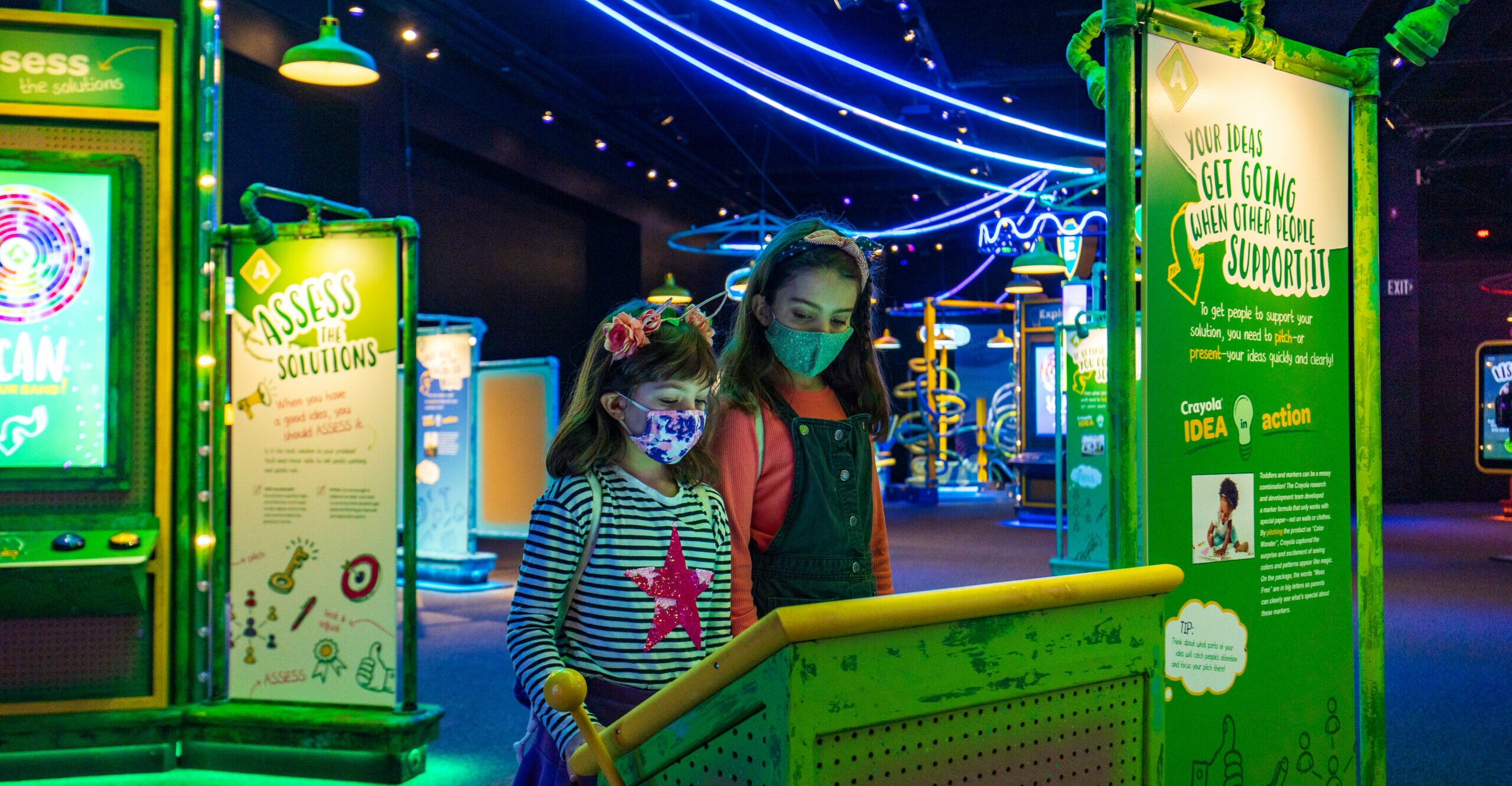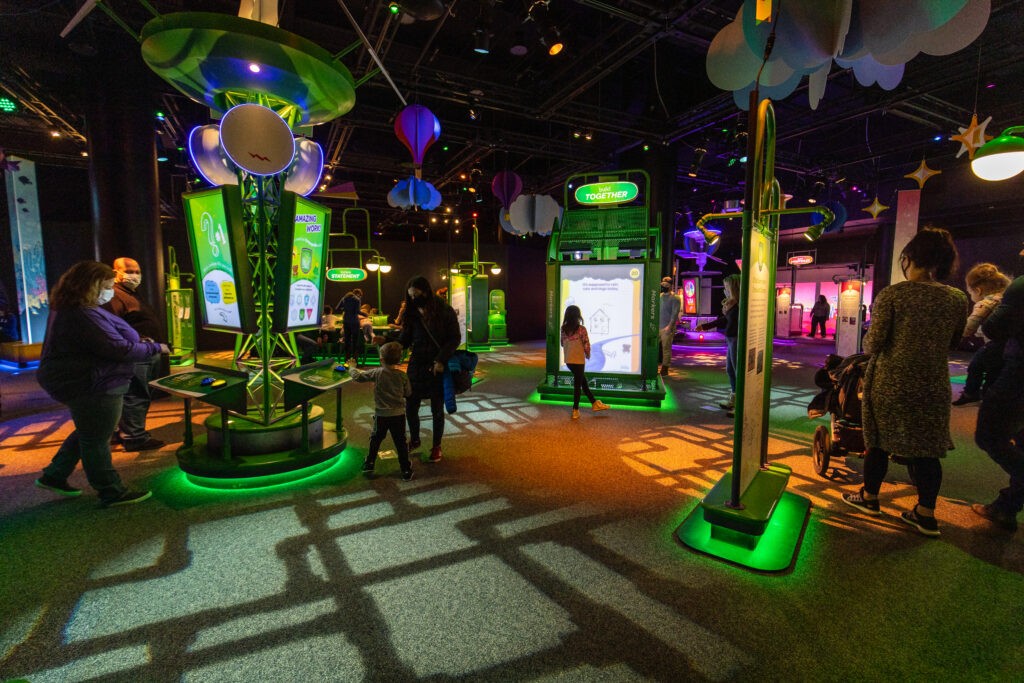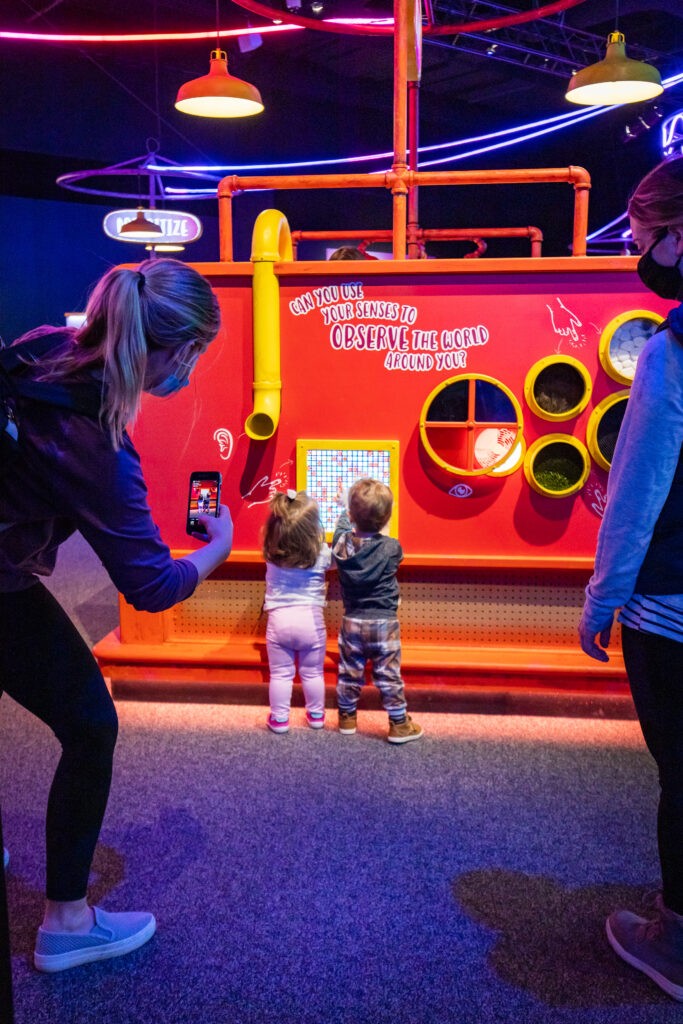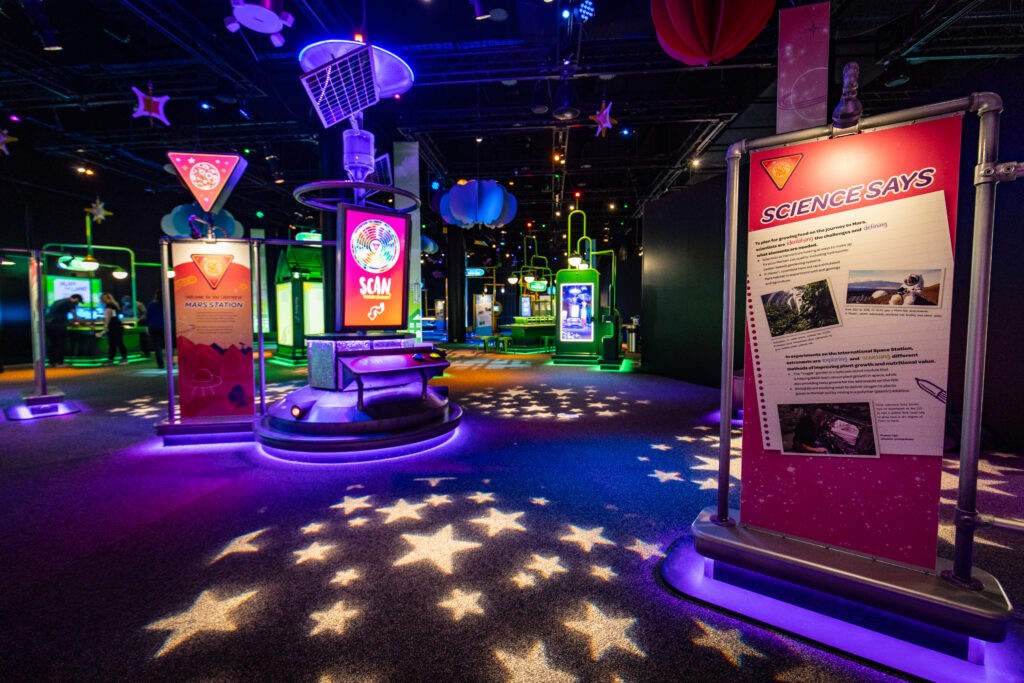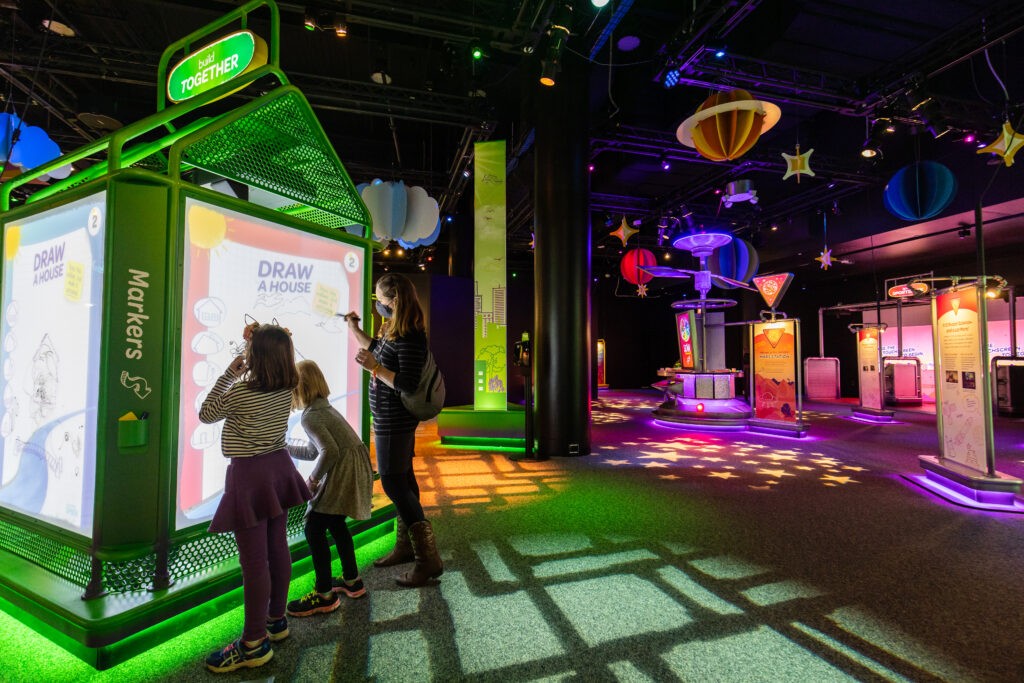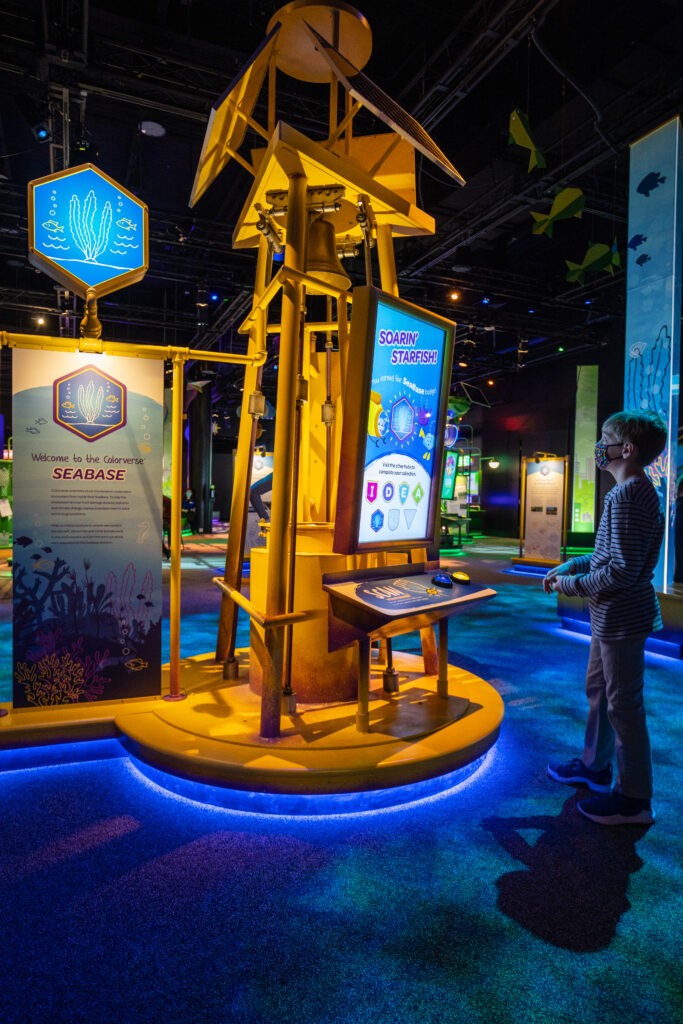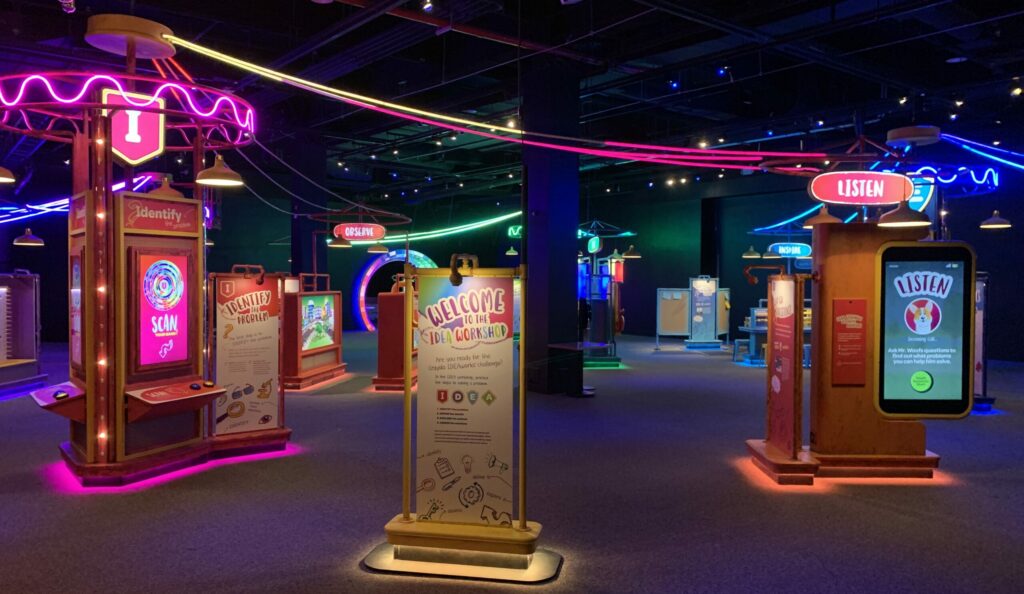by Joe Kleiman
PHOTOS courtesy Crayola and the project partners.
Crayola IDEAworks: The Creativity Exhibition is a new traveling exhibition that recently opened at The Franklin Institute in Philadelphia. While Crayola is famous for the 64-count box, you’ll find very little about that throughout the exhibition. “The focus of this exhibit is on the learning process designed to unlock creativity, design thinking, and innovation,” says Warren Schorr, Vice President of Business Development and Global Licensing for Crayola
Crayola IDEAworks teaches kids ages 6-12 the four important steps that lead to creativity with four actions that make up the acronym IDEA: Identify, Define, Explore, and Assess.
“Once they assess the situation, it often leads to new problems to identify,” says Cheri Sterman, Crayola’s Director of Education. “This is the design thinking process. Kids may also recognize it as similar to the scientific method or the instructions they receive from their art teacher. It’s the process we use in our everyday lives to solve challenges.”
The exhibit is split into two parts and involves both digital and physical interactives. The first section, the Workshop, introduces the IDEA concept and analyzes guests’ creative strengths. From there, they visit the Colorverse, made up of the city of Crayopolis, a Mars Station, and an underwater SeaBase, where they put their IDEA skills to action.
According to Clayton Ferguson, Managing Partner for the exhibition Producer Agency808, “Guests wear RFID wristbands throughout the exhibit. Using RFID, kids can personalize the experience to their favorite color. When you tap it at a hub, your profile pops up, and you’re asked a question. We collect information throughout the process, and at the end of the experience, the takeaway is the individual guests. They learn how to give back to the world, how to become an influencer or an inventor.”
Crayola and creativity
Crayola IDEAworks grew out of a meeting at the 2018 Licensing Expo between Ferguson, Schorr, and George Wade of Bay Laurel Advisors, advising Crayola. “We sat down and talked about creating an exhibit,” says Schorr. “The actual design process took a full year, with a fantastic team of exhibition experts, educators, our museum partner, and others, all contributing to the vision. The collaborative design thinking process was the same process we are teaching in the exhibition.”
Crayola IDEAworks is the third LBE concept developed by the creativity brand. It joins five Crayola Experience centers and the Crayola Imagine Arts Academy which provides afterschool learning, birthday parties, camps, and workshops through its 17 franchisees. “I was influenced by the Crayola Experience,” says Ferguson. “It was such an incredible immersion in creative play. Crayola provides the tools to unlock creative skills, and we wanted Crayola IDEAworks to help kids unlock their design-thinking skills.”
Color and Craymojis
Guiding guests throughout the 17,000 square foot exhibit are the Craymojis, whimsical or playful characters developed by Crayola to unlock feelings and emotions through color. “Color evokes responses in people, and everyone has an affinity or emotional response to colors,” says Crayola’s Sterman. “Some of this is culturally informed. We’re now starting to move away from prescriptive descriptions. We can empower kids by how different colors make them feel and use this in getting kids to think in a creative way. Part of creative thinking should be how colors make you feel. Doing this results in bright, confident thinkers.”
Collaborative activities
Larry Dubinski, President and CEO of The Franklin Institute, says, “We continue to know that learning works best when people are involved in activity and collaboration. Our brain exhibit showed this works well. It’s remained extremely successful.” The Franklin Institute’s largest permanent exhibit, opened in 2014, Your Brain uses physical and media interactives to explain how to unravel the secrets behind brain science. “We want to create an experience that people remember and have people say that they want to learn more. It’s about enjoying, learning, and doing more. Crayola IDEAworks accomplishes this.”
With not all schools in the region having reopened for in-person classes, we are offering an educator’s guide where instructors can teach the IDEA principles in virtual or physical classes. Students can then take what they’ve learned and go further in-depth at the exhibit.
The exhibit itself is designed for all ages to enjoy and can be experienced as individuals or as a group. “With the individual pieces and components you walk through,” says Dubinski, “children below 6 will find some fun things to do. Age 6 and above will want to work through these experiences. It’s a very inviting and colorful exhibit. Adults and teens will want to do it. The way the exhibit’s laid out fosters engagement throughout.”
“One of the core beliefs shared in the exhibit,” adds Ferguson, “is that collaborative and empathetic thinking are the core to problem-solving. This exhibit is a team-building experience. It uses creative problem solving, but instead of everyone having a different role based on their strengths, like Dad is good at math, Mom is good at puzzles, etc., it teaches that we all have gifts and skills to solve on our own. Everyone is creative.”
Exhibiting during a pandemic
It’s very interesting designing an exhibition in and of itself,” Ferguson shares, “Creating an exhibition in a COVID-19 scenario makes it even more of a challenge because the team is spread out. We became good at designing as a collaborative group. In fact, a lot of the team didn’t physically meet until a few days before opening. Our fabricator was in Canada, near Toronto. Typically during a build, you go to visit the shop to check on progress in person. We weren’t able to because of COVID-19. It’s a much different experience to see your project via images than to see it in person. In fact, we didn’t see in person until three weeks before opening.”
The Franklin Institute is operating the exhibit, like the rest of the museum, with full COVID-19 health and safety measures in place, including social distancing protocols, mask requirements, and temperature checks. Because Crayola IDEAworks involves physical interaction, staff are consistently wiping down the interactives. Operating at 25%, the museum has been offering reserved timed entry on an hourly basis. With all the health and safety measures in place, the exhibit’s opening over President’s Day Weekend quickly sold out, with most purchases made via online bookings. Guest feedback has been extremely positive.
“We’re really focused on the present,” says Dubinski, “I feel really good about how this exhibit will do now at this time. People are looking for engaging, safe experiences. Crayola and Agency808 have created that. People around the region are very excited about this. Despite the challenges during COVID-19, I’m proud of the end product.”
Touring exhibition
Crayola IDEAworks will continue its run at The Franklin Institute through July 18, 2021, after which it will begin a national tour. Ferguson is considering possible touring units for Europe and Asia. “Crayola is big on both continents,” he says,” and we’d likely expand the exhibit because exhibits tend to be larger in those regions.”
Crayola’s Schorr points out that the exhibit’s hub experiences are designed to be changed out with other activities to keep the exhibition fresh as it travels. “Crayola IDEAworks can keep touring as long as there are new, inventive ideas and ways to foster creativity,” he says.


